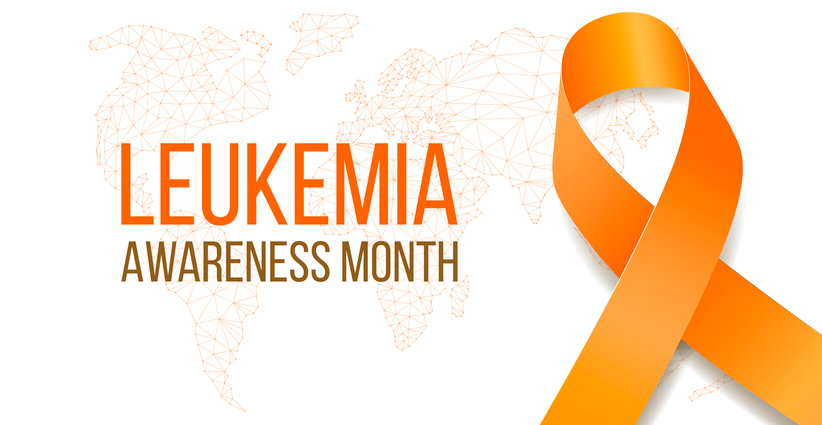Commitment + Clinical Leadership = Better Outcomes

12 Facts about Leukemia
Leukemia is a cancer that forms in the body’s blood forming tissues and usually occurs when the body produces too many white blood cells. White blood cells in the body protect you from disease and infection, but too many white blood cells can throw off your body’s natural defense system off.
Here are 11 must-know facts about leukemia to help you learn more about it and how you can help those who have it.
Leukemia Can Grow Fast or Slow
There are two main growth types of leukemia. They are:1
- Acute Leukemia. Acute Leukemia is fast growing and can be fatal if left untreated.
- Chronic Leukemia. This leukemia spreads slowly and will become fatal over time.
Doctors Use White Blood Cells to Diagnose Each Leukemia Type
Doctors diagnose leukemia based on the type of white blood cell involved - lymphocytes or myeloid cells. Lymphocytes come from cells in the bone marrow that create T cells, B cells, and NK cells that help the immune system fight infections. Myeloid leukemias create cells that release enzymes to protect the body when bacteria or fungi enter and try to cause disease.2
There are 4 Types of Leukemia
The most common types of leukemia (in this order) include:3
- Chronic lymphocytic leukemia. A slow growing cancer that begins in the bone marrow lymphocytes and spreads into the blood.
- Acute myeloid leukemia. This leukemia type occurs rapidly and spreads through the bloodstream.
- Chronic myeloid leukemia. A fast-growing cancer found in the bone and blood marrow that overproduces white blood cells.
- Acute lymphocytic leukemia (ALL). ALL occurs when the bone marrow creates too many lymphocytes.
Different Types of Leukemia Affect Different Age Brackets
Acute lymphocytic leukemia (ALL) affects primarily children, with 3 of 4 cases being this type. The most common type of Leukemia for seniors is Acute myeloid leukemia (AML). Research is currently ongoing to discover why different types of leukemia affect people of different ages.4
Leukemia Affects People Primarily Over 55
Another interesting fact about leukemia is it primarily affects older adults, with most people receiving a diagnosis at 66. The most common age for people to be affected by leukemia is 55, making this a cancer many older adults face.5
Leukemia is the Most Common Cancer in Children
While leukemia can happen to anyone at any age, it is the most commonly diagnosed cancer in childhood, making up 1 out of every 3 cases.6 However, the good news is leukemia is still a rare childhood disease overall, and it is rarely fatal to kids.
186,400 People in the US were Estimated to be Diagnosed in 2021
Every 3 minutes, an individual is diagnosed with leukemia, lymphoma, or myeloma. A 2021 estimate was that these conditions would affect roughly 186,400 people in the US.7
Survival Rates Are High
Another leukemia fact is the five year survival rate for cases of leukemia of all ages is 65%. Leukemia death rates have fallen by 2% every year since 2019.8
Men Are At Higher Risk
Men are 31% more likely to get leukemia than women. They also have a higher leukemia mortality rate that is 30% higher than females.9
The Cause of Leukemia is Unknown
Currently, researchers are unsure what the direct cause of leukemia is. However, some risk factors include:10
- Smoking
- Family history
- Male gender
- Radiation exposure
- Benzene exposure
- Chemotherapy
- Agent orange exposure
Symptoms Vary By Case
Another leukemia fact is the signs and symptoms can vary based on the type and severity. Some of the most common signs of leukemia include:11
- Easy bleeding/bruising
- Fatigue
- Chills
- Weight loss
- Nosebleeds
- Spots on the skin
- Sweating
- Bone pain
- Bone tenderness
Doctors Can Diagnose Leukemia in 3 Ways
Another fact about leukemia is it can be diagnosed in multiple ways. These include:12
- Physical exam. When a doctor inspects the body for signs of leukemia, such as bruises.
- Blood tests. A patient with leukemia will have an imbalance of white blood cells or platelets. Some leukemia cells can also be found in the blood samples.
- Bone marrow. A doctor will take a sample of your bone marrow – usually from your hip bone – and analyze it for the presence of leukemia cells.
When to See a Doctor
If you suspect that you or a loved one might have leukemia, make an appointment immediately. Your doctor will be able to properly diagnose your case and instruct you on the next steps.
Oftentimes, leukemia may be diagnosed when a doctor performs tests to find other conditions.
Saber Healthcare is an organization dedicated to providing consultant services to long-term care providers. This article is for informational purposes and is not meant to be seen as professional advice. Please consult with a medical expert before relying on the information provided.
Sources
- https://medlineplus.gov/leukemia.html
- https://www.mskcc.org/cancer-care/types/leukemias/types
- https://www.cancercenter.com/cancer-types/leukemia/types
- https://www.healthgrades.com/right-care/leukemia/9-surprising-facts-about-leukemia
- https://www.medicinenet.com/life_expectancy_of_a_person_with_leukemia/article.htm#:~:text=In%20adults%2C%20leukemia%20is%20most,is%20higher%20for%20younger%20people.
- https://www.lls.org/blog/5-essential-facts-you-should-know-about-leukemia
- https://www.lls.org/facts-and-statistics/facts-and-statistics-overview
- https://www.healthline.com/health/leukemia/survival-rate-of-leukemia
- https://www.stelizabeth.com/healthyheadlines/facts-about-leukemia/
- https://www.verywellhealth.com/leukemia-facts-5324565
- https://www.mayoclinic.org/diseases-conditions/leukemia/symptoms-causes/syc-20374373
- https://www.mayoclinic.org/diseases-conditions/leukemia/diagnosis-treatment/drc-20374378
